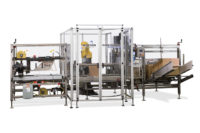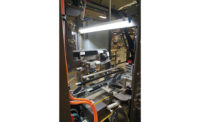Flexible packaging is used as primary packaging in a wide range of sectors, like the beverage, food, home and personal care industries. Due to the opportunities it provides –from a marketing, profitability and logistics perspective – it is growing in popularity worldwide. However, this type of container presents inherent constraints as well as challenges when it comes to automating the packing process. Etienne Henry, packaging business development director at Sidel, shares his expert insights into flexible packaging for food applications.
Q1: Sidel has been well renowned in the beverage industry for decades. Why now suddenly talk about food, home and personal care markets? For over five decades, Sidel has been serving the food, home and personal care industries’ needs.
We are a sustainable partner in packaging and line design with tailored solutions, innovations and services. Our solutions enable product creativity and help achieve high levels of flexibility, operability, maintainability and efficiency to meet current and future trends as well as emerging challenges.
One of our focus areas is the food market, where we intend to solve the issues linked to the case packing of flexible packaging. As of today, our offering with regard to this segment is very much centred on packing in corrugated cases, palletising and line integration. Through continuously understanding our customers’ challenges, we work to deliver smart advanced systems and innovative packaging line solutions to boost our customer’s agility in managing their lines, products and businesses throughout the entire lifecycle. We aim for design capability at every step from packaging to line definition, enabling our customers to stay ahead thanks to creative solutions.
Q2: Why this focus on flexible packaging in these sectors?
According to the latest Smithers Pira report from May 2019, the global total volume consumption for flexible packaging will grow at an annual rate of 4.0% from 2019 to 2024, increasing from 29.9 to 36.4 million tons of these packaging solutions. Flexible packaging is growing in popularity worldwide due to different factors: it brings economic and logistic benefits, it is fully adapted to modern uses and answers needs such as mobility and convenience in the form of ready-to-use products. When combining our familiarity with this type of packaging and our expertise in robotics, Sidel can be a great fit in this sector.
Q3: Why is secondary packaging such an important factor to master projects for the automation of flexible packaging?
Packing is a core part of the industrial process. Choosing the right secondary packaging is essential for any flexible packaging automation project, as it provides essential protection and stability to compensate for the unstable geometry and obvious lack of resistance or rigidity of flexible packaging.
Depending on varying producers’ wishes and logistical constraints, such as “easy opening” boxes, products standing up or lying flat in the case, the level of protection needed or the optimization of the case filling in terms of surface area and cost, Sidel offers several configurations and solutions. Via our portfolio, we enable our customers to handle many different alternatives, such as RSC cases, Wrap-Around blanks and Shelf-Ready Packaging.
It is key to keep in mind that there is no “one-size-fits all” solution. You will make a real difference when handling flexible packaging, thus improving product integrity, packaging quality and line performance, if you choose the right solution among the wide range of product infeed and packing systems. All of this, while considering the factory’s configuration and challenges.
Q4: What value are you as an equipment supplier bringing to this market?
The mechanization process of flexible packaging can easily present issues when it comes to product handling and packing. This is due to the lightness and deformability of this kind of primary packaging. Its so-called unstable geometry has five major consequences: no accumulation possible, no counter-pressure to seal secondary packaging, no or little resistance to vertical compression of the secondary packaging on the pallet, limited protection of the product inside and risk of causing case crashes and, thus, pallet instability.
Sidel is able to provide several appropriate solutions for primary packaging, starting with traditional side-loading packers up to more sophisticated systems, enabled by our long-term expertise in robotics. Robotic packing represents the perfect alternative when the process requires a significant flexibility to handle high packing speeds and high number of SKUs. For other needs, a simpler type of manipulator (for factories with lower speeds and more standard packing configuration) is more recommendable.
There are three key areas of expertise you need to master to set up an automatic packing solution for flexible packaging that is able to ensure maximum efficiency and the best possible return on investment. First, consider the constraints inherent to primary packaging, in particular during conveying and handling. Secondly, our company has more than 50 years of experience in secondary packaging. Last but not least, we come with an important legacy in mechanization and automation, which allows us to always design and deliver solutions which are tailored to the specific needs of our customers.
Q5: Do you have recent experiences to share?
Certainly: Frisian Flag – an Indonesian customer – approached us for a solution for packing chain bags into Wrap-Around blanks. The challenge was to find the right solution for folding the chain bags, placing them into flow packs and then positioning these flow packs in Wrap-Around cases. All of this while keeping the batches firmly grouped throughout the whole process. Therefore, we decided to install a Cermex WB46, a twin lane infeed Wrap-Around packer with a robotic arm. This fully automated solution was able to eliminate all the operations that were previously performed manually, while ensuring a stable, optimal packing and secure case filling. With another customer, a recent challenge has been the packing of liquid refill pouches standing up into RSC cases.
In another project, we had to find a creative way to pack pouches with spout lying flat in the case, yet optimizing the case filling and/or reducing its size. Alternatively, we have also had customer success with packing stand-up pouches of coffee in an upright position, leading to a shelf-ready, easy-shelving packaging for the retailer. In fact, those real life experiences are widely covered in a white paper we have recently compiled, addressing the current state-of-the-art options and solutions with regard to flexible packaging and secondary packaging options for the food industry.
Q6: Can this white paper be used when starting an automation project with flexible packaging?
The simple answer is: yes. The white paper highlights all questions, options and challenges that need to be asked or met in order to make such a project a success. To point manufacturers in the right direction when tackling the topic of automation, we have also identified 12 factors they should consider when designing an automatic packing line. Those include the available types of flexible and secondary packaging, the logistics process, as well as the type of conveying system, to name but a few. In the end, the paper can be helpful in the construction of a specification document when starting a bidding process.
For more information, download our white paper on automatic case packing of flexible packaging by clicking here:



